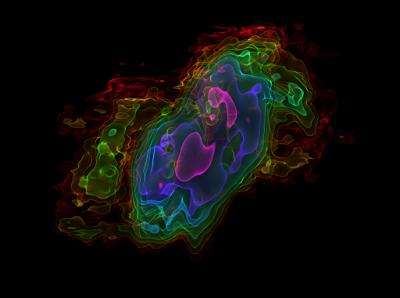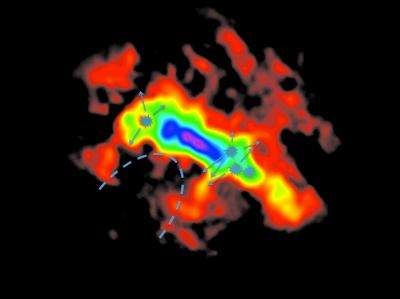Starburst to star bust: Astronomers ID suspect behind dearth of high-mass galaxies

A new study published in the journal Nature shows how vigorous star formation can turn the tables on a starburst galaxy by forcing hydrogen and other gases high into the surrounding galactic halo, leaving little fuel for the next generation of stars.
These new observations may help solve the mystery of the missing high-mass galaxies that theories predict should exist, but are conspicuously absent.
Astronomers using the new Atacama Large Millimeter/submillimeter Array (ALMA) telescope have discovered billowing columns of cold, dense gas fleeing the disk of nearby starburst galaxy NGC 253, also known as the Silver Dollar Galaxy. Located 11.5 million light-years away in the constellation Sculptor, this galaxy—with its slightly askew orientation—offers astronomers an uncommonly clear view of several super star clusters near its center. These clusters denote areas where new stars are forming and they also mark the starting point for material being ejected from the galaxy.
"With ALMA's superb resolution and sensitivity, we can clearly see for the first time massive concentrations of cold molecular gas being jettisoned by expanding shells of intense pressure created by young stars. The amount of gas we measure gives us very good evidence that some growing galaxies spew out more gas than they take in," said Alberto Bolatto of the University of Maryland in College Park and lead author on the paper. "We may be seeing a present-day example of a very common occurrence in the early Universe."
These results may help explain why astronomers have found a surprising paucity of high-mass galaxies throughout the cosmos. Computer models show that many older galaxies should have considerably more heft and a larger stellar content than we currently observe. It's possible to account for this discrepancy by setting up some form of galactic winds or outflow of gas, which would deprive the galaxy of the fundamental material to form new stars.
One way to remove gas from a galaxy is to have gas falling in on a central supermassive black hole. As material swirls toward the black hole, it becomes superheated and produces powerful jets that can propel material far from the galactic disk and can even seed the intergalactic medium with heavy elements. But there is no indication that NGC 253's central black hole is currently active.

The other potential source of galactic winds is star formation, but until now this had not been observed with enough resolution or sensitivity to measure its impact on subsequent star formation or the outflow of gas.
As new stars form they exert powerful destructive influences on their environment. Initially, their light and winds of particles push on the surrounding gas. Later, if they are massive enough, stars explode as supernovas, a process that further drives the surrounding material away from the stellar birthplace. In NGC 253, the concentration of hundreds or thousands of such destructive stars in one place appears to have the effect of launching powerful flows of gas out of the galaxy.
"ALMA is opening a new window for observations of galactic winds," said Sylvain Veilleux, also at the University of Maryland and a coauthor on the paper. "Winds have the potential to be incredibly disruptive and carry away a significant fraction of the star-forming material of a galaxy."
Previous observations in the X-ray portion of the spectrum revealed hot ionized hydrogen streaming away from NGC 253's star-forming regions. This gas, however, is very tenuous and alone would have little if any impact on the fate of the galaxy and its ability to form future generations of stars.
The new ALMA data show the far-more-dense molecular gas getting its initial "kick" from the formation of new stars and then being swept along with the thin, hot gas on its way to the galactic halo. "These features trace an arc almost perfectly aligned with the edges of the previously observed hot, ionized gas outflow," noted Fabian Walter, a lead investigator at the Max-Planck Institute for Astronomy in Heidelberg, Germany, and a coauthor of the paper. "We can now see the step-by-step progression of starburst to outflow."
Using only a portion of its eventual full complement of 66 antennas, ALMA was able to measure the mass and motion of carbon monoxide (CO) in the gas ejected from the central regions of this galaxy. The researchers determined that vast quantities of molecular gas—likely 9 times the mass of our Sun and possibly much more—were being ejected from the galaxy each year. At this rate, the galaxy could run out of gas in as quickly as 60 million years. This would add up to be more gas than actually went into forming stars.
The researchers also determined that the gas is traveling anywhere between 40 to 250 kilometers per second, streaming approximately 1,500 light-years above and below the disk. This may not be fast enough for the gas to reach escape velocity from the galaxy. If not, the gas will likely get suspended in the galactic halo for many millions of years.
"More studies with the full ALMA array will help us figure out the ultimate fate of the gas carried away by the wind," said Adam Leroy with the National Radio Astronomy Observatory in Charlottesville, Virginia. "This will help us understand whether these starburst-driven winds recycle or truly remove star forming material."
"These spectacular results give an idea about the full power of ALMA when it will operate at its total capacity," adds ALMA Director Pierre Cox.
More information: Nature Doi: 10.1038/nature12351
Journal information: Nature
Provided by National Radio Astronomy Observatory




















